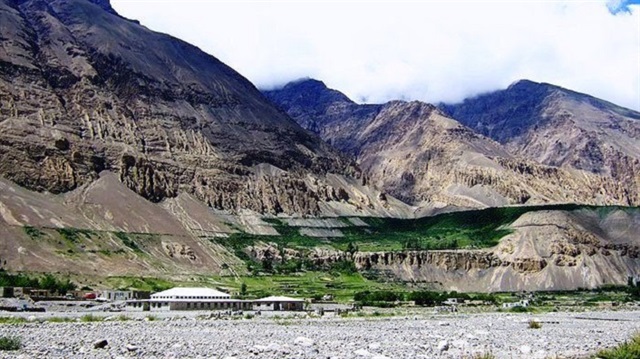
It takes around three-and-a-half hours by jeep over a treacherous mountain road, only opened in 2004, to reach the Shimshal Valley after leaving the newly paved Karakoram Highway at the village of Passu.
The most famous local resident is Samina Baig, the first Pakistani woman to climb Mount Everest. Other than that, the four small villages in the Shimshal area stay mostly out of the news.
Even glacier-related floods last August, which destroyed bridges and damaged roads, leaving the valley inaccessible for a week, barely received coverage in the national press.
But Pakistan has reason to pay attention to Shimshal, because the Khurdopin glacier is known for causing periodic glacial outburst floods that have led to massive destruction downstream.
The Shimshal River meets up with the Hunza River, which in turn feeds the Indus, the country’s most essential waterway.
When the approximately 47-km-long (30-mile) Khurdopin glacier collides with the side wall of the rocky valley, it blocks the river, and a temporary lake forms behind it as the water piles up.
The lake expands for several months and then can burst through the blockage as the glacier retreats again.
By January of this year, the lake was already about 1.5km (1 mile) in length.
Experts say that in the past, millions of cubic feet of lake water have rushed into the Hunza River, destroying everything along the way.
According to local people, these lake outbursts floods have happened several times – in 1920, 1942 and in the early 1960s. There was also a smaller amount of flooding last July.
“Our elders still remember those earlier massive floods,” said Karamat Ali, a documentary film-maker who lives downstream in Karimabad. He hiked up to the frozen lake in Shimshal last December.
“It has become huge and it is very dangerous indeed, both to Shimshal Valley residents who live close to the river and those living downstream,” Ali said in a telephone interview.
Scientists studying the Khurdopin glacier using satellite imagery have confirmed that it is moving at a rapid pace.
A study by Utrecht University reported that during a few weeks in 2017 the glacier’s velocity peaked at the equivalent of 5 km a year, among the fastest rates reported globally.
The situation has the local people, FOCUS and the province’s Disaster Management Authority worried. No one knows for sure if there will be a high-intensity outburst and when it might happen. All are preparing for flooding, whether it’s small-scale or much larger.
Ghulam Rasul, head of the Pakistan Meteorological Department, who viewed the glacial lake from a helicopter last December, estimates that it is at 70 percent of its capacity, with no inflows at the moment, but that it will fill up further as ice begins to melt around the end of March.
“In mid-March, inflows will start increasing. In April it will reach a high-risk position. In my opinion the lake will flow over the ice or make a channel for itself through the ice. I don’t expect a sudden outburst,” Rasul said.
Communities living downstream are not taking any chances. With the help of FOCUS they have set up an early warning system using satellite images and cellular phones.
A monitoring team trained by geologists regularly hikes up to the glacier to gather data.
Community response teams have also been set up to respond to disaster alerts and help evacuate people if needed. They are trained in first aid and equipped with tents, blankets and rescue tools.
“The awareness-raising sessions and emergency response drills at the community level have made us learn about hazards and the immediate steps we need to take as first responders, so women and children in our village feel much safer than they did a few years ago,” said 39-year-old Zeenat, a resident of Shimshal village.
Rasul said that, contrary to appearances, climate change is in fact responsible for an increase in the frequency of the glacier surges.
Scientists say unusual warming in the Arctic may be linked to more winter storms further south.
Rasul, however, believes that the “Karakoram Anomaly” will not last long.
“As temperatures rise further, even these glaciers’ mass balance will gradually reduce as the freezing level is moving upwards,” he said.
In the meantime, however, residents of the Shimshal valley are keeping a watchful eye on their glacier – and the frozen lake behind it.














